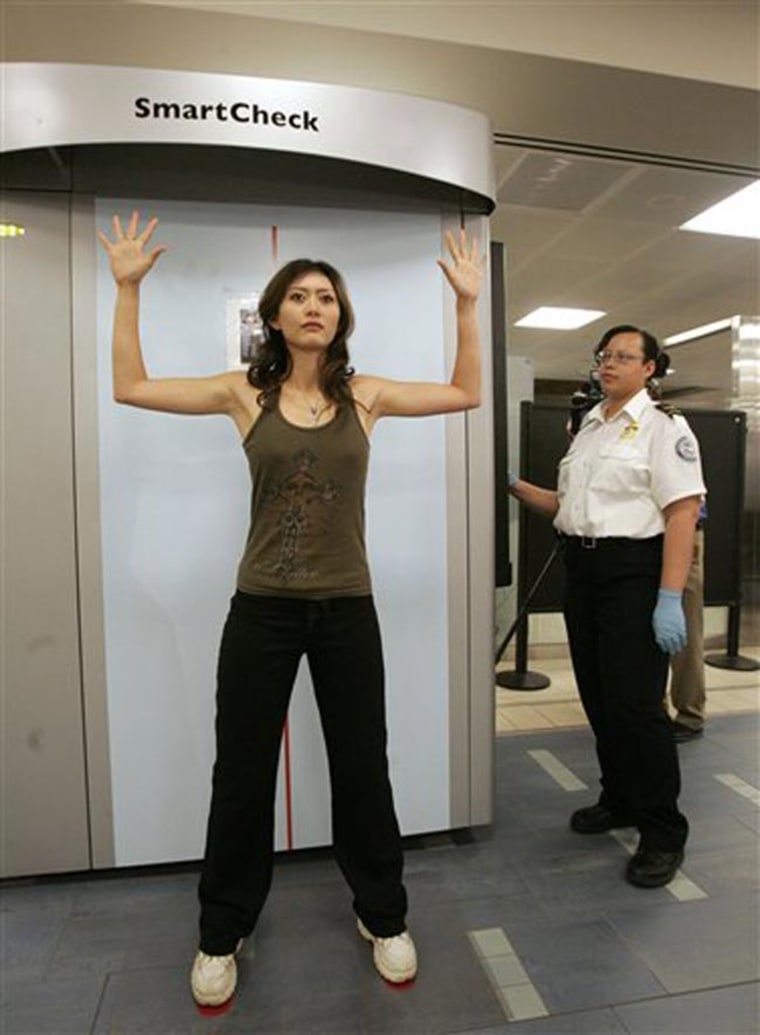Backscatter X-ray and millimeter-wave imaging technologies that give Transportation Security Administration (TSA) officers the ability to see through passengers’ clothing and look for prohibited objects hidden next to their bodies are being used at an increasing number of U.S. airports.
Voluntary use of the technologies by travelers reportedly has been high, even though the new technologies allow security screeners to see intimate details of passengers' bodies and personal medical items.
A traditional X-ray machine detects hard and soft materials by the variation in radiation passing through an object. Backscatter X-ray units detect the radiation coming back from the person or item being scanned, so in effect they work much more like radar scanners rather than traditional X-ray machines.
“Millimeter Wave technology, another form of body-imaging technology, uses non-ionizing electromagnetic waves to generate an image based on the energy reflected from the body,” the TSA says on its Web site.
Pilot program expands
In February 2007, the TSA began a backscatter X-ray passenger screening pilot program at Phoenix Sky Harbor Airport (PHX). The program was expanded in May to Los Angeles International Airport and last month to New York John F. Kennedy International Airport.
Backscatter screening machines generate a narrow, low-intensity X-ray beam that scans a passenger at high speed. The amount of radiation during the scan is equal to 15 minutes of exposure to natural background radiation on a sunny day.
The system “creates an image that looks like a chalk outline of the passenger with threats outlined, but does not reveal facial features," according to Billerica, Mass.-based American Science and Engineering (ASE), manufacturer of the SmartCheck Z Backscatter Personnel Screening System used by the TSA. Additionally, "the SmartCheck systems installed at JFK, LAX and Phoenix Sky Harbor cannot store, export, print or transmit images.”
Backscatter X-ray imaging stops at flesh and is used for secondary screening as an alternative to pat-down searches, and passengers are given the option, explained TSA spokeswoman Lauren Wolf.
“To date, approximately 90 percent of passengers have opted for screening using SmartCheck rather than undergoing a pat-down,” ASE said in May.
Millimeter wave scanners
In October 2007, L-3 Communications announced that TSA had begun testing its L-3 ProVision millimeter-wave body-screening portals at PHX.
“L-3’s millimeter-wave technology pinpoints objects made of any material, including liquids, rubber, wire, plastic, and metal, to quickly and easily locate weapons, contraband, and other threats concealed under an individual’s clothing," the company said. "The portals detect concealed and hidden objects such as metallic and non-metallic weapons and virtually all known explosives, and other contraband in seconds."
“The images generated through millimeter wave are lower-resolution than that of X-ray backscatter, and as a result, privacy may be less of a concern for the traveling public,” the TSA said.
According to Farran Technologies, an Irish manufacturer of millimeter-wave scanners, the technology exists to extend the screening area to approximately 160 feet. Given this capability, people in airports could be scanned by security personnel without their knowledge.
Wolf said there are now 38 millimeter-wave scanners in use at U.S. airports, with an additional 82 units to be deployed by the end of next year.
Privacy concerns
Barry Steinhardt, director of the Technology and Liberty Program of the American Civil Liberties Union, met with TSA Administrator Kip Hawley in October 2007 to discuss passenger-imaging technologies such as active millimeter wave. Steinhardt subsequently expressed his concerns in a public statement.
“First, this technology produces strikingly graphic images of passengers’ bodies. Those images reveal not only our private body parts, but also intimate medical details like colostomy bags. That degree of examination amounts to a significant — and for some people humiliating — assault on the essential dignity of passengers that citizens in a free nation should not have to tolerate," Steinhardt said
"Second, we question the supposed voluntary nature of this scan — TSA’s assumption that the people who "consent” to this body scan really understand what they’re consenting to, and that it will long remain something over which passengers will be allowed to exercise any choice at all," he continued.
"Third, we are skeptical of the privacy safeguards that the TSA is touting," said Steinhardt. "They say that they are obscuring faces, but that is just a software fix that can be undone as easily as it is applied. And obscuring faces does not hide the fact that rest of the body will be vividly displayed.”
